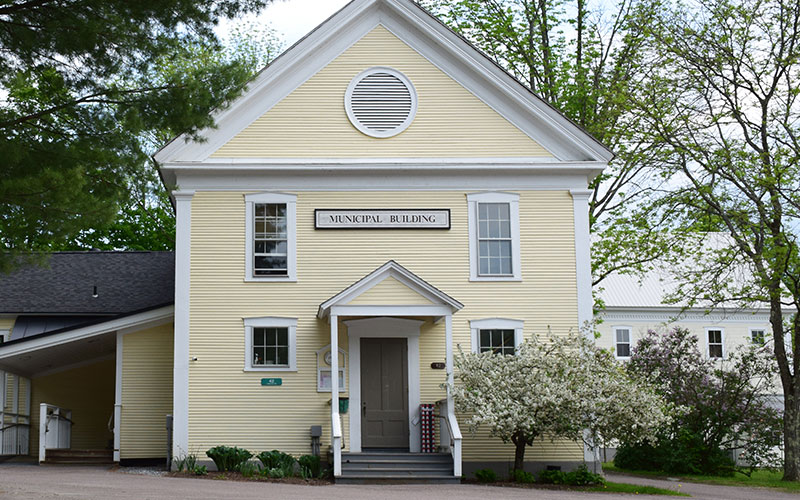After the Warren Select Board and Planning Commission considered proposed changes to the telecommunications section of town’s proposed Land Use and Development Regulations (LUDRs) on Monday, March 14, those boards met with Sugarbush representatives to discuss specific concerns the resort has with the proposed new regulations.
In a lengthy meeting on March 14, a wide-ranging discussion of several key points took place. Sugarbush’s director of planning Margo Wade offered specific discussion items to which the select board and planning commission responded, along with planning consultant Brandy Saxton.
Wade opened by noting that the resort feels the new LUDRs will create a burden on the town in terms of implementing and managing them because they are so different and comprehensive. She noted that the current applications for projects are already “stale” in terms of usability with the new regs.
REDUCE FLEXIBILITY
The discussion moved onto how house nonconforming structures are treated in the new regulations; Wade pointed out that the new regs reduce flexibility in terms of improving nonconforming structures in requiring the structure to stay the same size and height if it is rebuilt.
She said that that was why the resort applied for its two workforce housing projects in early January to be able to apply under the existing regs versus the new ones. She used an example of the Sugar Tree Inn which the resort owns and said it was likely Sugarbush would want to redevelop that property by tearing down the existing building with a funky house, three-story lodge and cockeyed footprint and would be unable rebuild by squaring off a new building.
Saxton responded that she felt that was a misinterpretation and that the rebuild just couldn’t increase the degree of nonconformity. Wade asked for clarification and Saxton said the new regs don’t allow increasing height of a nonconforming building.
Select board chair Luke Youmell said impeding housing at Sugarbush by restricting height did not make sense.
INCREASES DENSITY
Board member Bob Ackland concurred, noting that adding a floor increases density. Saxton said the town could change the dimensional requirements for that district, the resort mixed use district.
During a discussion of how the new regs address workforce housing, Wade and Sugarbush CEO John Hammond questioned why the limit on individual workforce structure was 36 people. Wade asked why there would be limits if water and wastewater were available. Both acknowledged that in earlier discussions with the planning commission they had identified 36 international employees as the right sized cohort for congregate living.
Hammond explained that earlier thinking, before Alterra bought Sugarbush, was a dormitory type building for workers than envisioned bunkrooms with as many as four people to a room. The current workforce housing projects under review are offering single rooms for employees because that is what employees want in a competitive labor market. He said the resort would be upgrading the fit and finish of those facilities in response to the market.
EMPLOYEE HOUSING
The group then discussed whether employee housing projects, regardless of the size, should have something akin to the RA (residential advisor) of a college dorm floor. Wade pointed out that regardless of whether the resort has an onsite manager, imposing limits on number of people was a deterrent to development. Select board members ultimately concurred.
Ackland said that to require an RA for Sugarbush workforce housing was discriminatory. He added that the town is working on land use regulations rather than personal behavior regulations and said there were other ways to regulate behaviors.
The discussion returned to building height and select board and planning commission members agreed that it should be increased from 48 feet max to 50 with a waiver allowing buildings to be 30% higher, or 65 feet, which would allow for six-story buildings.
A lengthy discussion over how the new regulations impact master planning and pre-existing master plans and previously approved projects. Wade said the new regulations create a burden by requiring masterplans that encompass all resort land holdings in Warren as well as Fayston and Waitsfield when contemplating changes. She said the new regulations effectively negate prior land use approvals that could have a negative impact on prior Lincoln Peak base area redevelopment plan approvals.
‘DONUT’
She also pointed out that the Lincoln Peak base area redevelopment plan envisioned a ‘donut’ of development encircling Lincoln Peak and said that only three lots, C, D and E were still undeveloped in that plan. Calling these lots the ‘donut hole,’ she said that having to redo the entire master plan for Lincoln Peak would be costly and could result in losing approvals.
Saxton explained that regardless of how the LUDRs are amended, there is going to be a need to bring the pre-approved projects forward to the new regulations. She said the prior approvals aren’t permits. She said the resort had partial and conceptual approvals.
After further discussion the board agreed to revisit this issue, specifically with regard to the donut hole, but more conceptually with how the new regulations treat master planning.
The discussion continues March 23 at 6:45 p.m.













